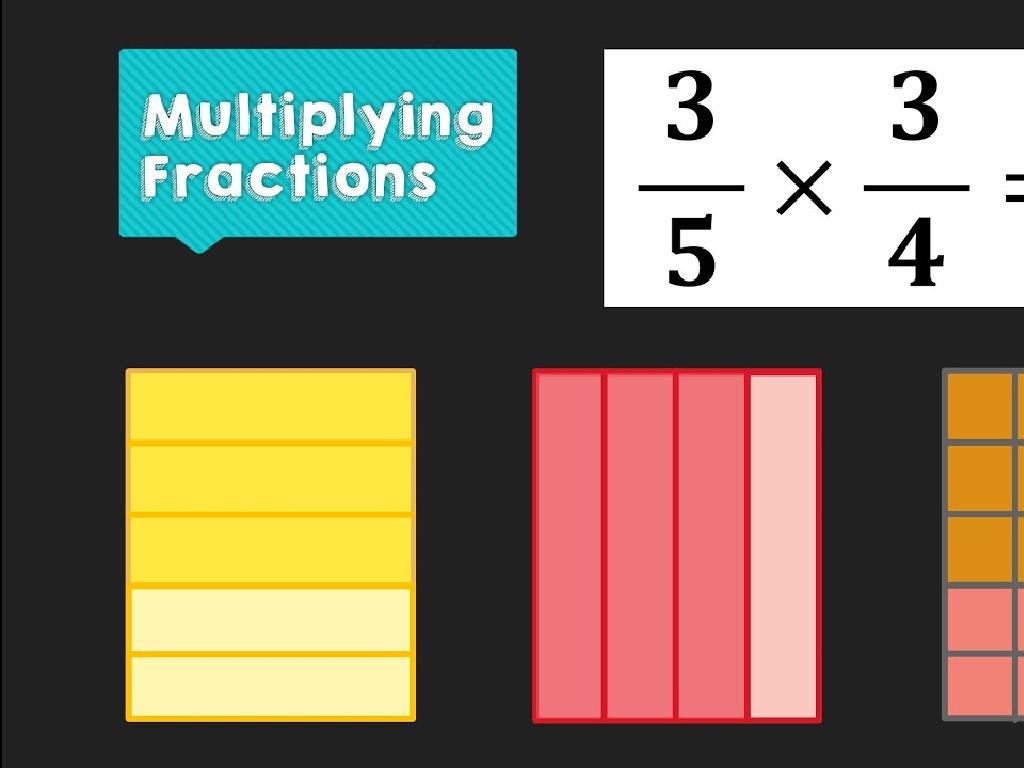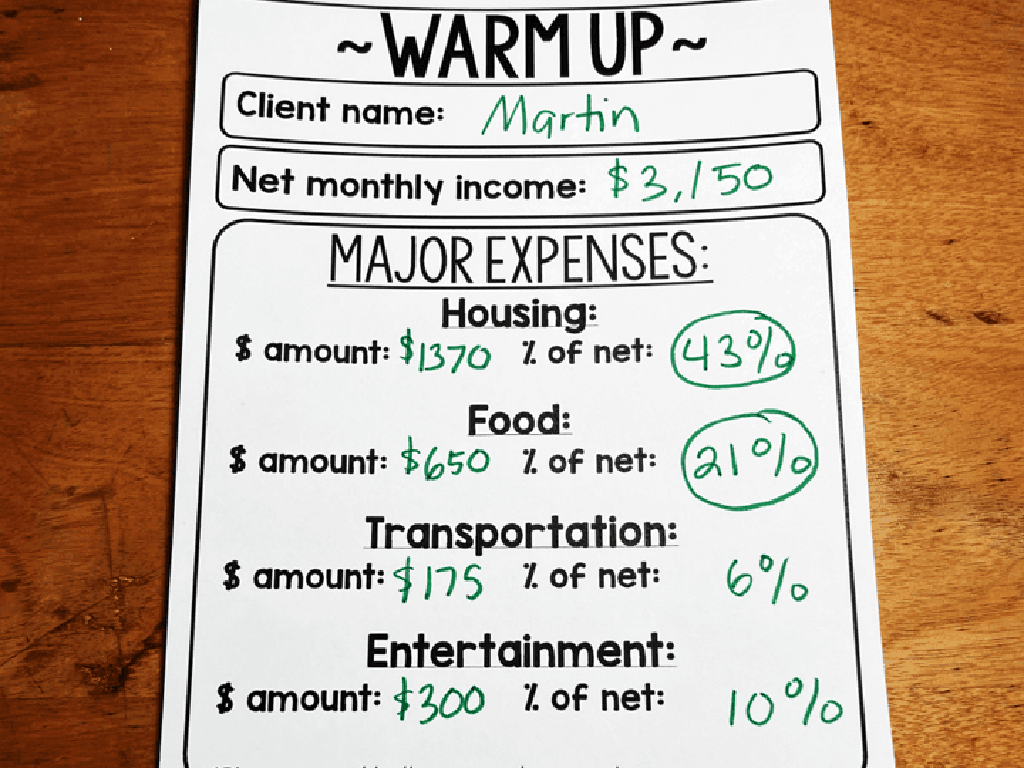Divide Decimals
Subject: Math
Grade: Seventh grade
Topic: Operations With Decimals
Please LOG IN to download the presentation. Access is available to registered users only.
View More Content
Introduction to Decimal Division
– Understanding decimals and division
– Decimals represent fractions; division is sharing equally.
– Review decimal place values
– Each place to the right of the decimal decreases by 10x.
– Significance of dividing decimals
– Mastering this skill is crucial for real-world problems.
– Practical applications
|
This slide introduces the concept of dividing decimals, which is a foundational skill in mathematics. Start by explaining what decimals are and how they relate to fractions, then discuss the process of division as a method of distributing a number equally. Review the value of decimal places, emphasizing the pattern of each place being ten times smaller than the one before it. Highlight the importance of learning to divide decimals, as it is a skill frequently used in various aspects of daily life, such as calculating money, measurements, and data analysis. Provide examples to illustrate practical applications, such as dividing a bill among friends or measuring ingredients in a recipe. Encourage students to think of other scenarios where they might need to use decimal division.
Review of Division Basics
– Recap division terms
– Dividend, Divisor, Quotient, Remainder: parts of division
– Understanding division
– Division is sharing equally among a number
– Simple division examples
– For example, 20 ÷ 4 = 5. No remainders here!
– Transition to decimals
|
Begin the lesson with a quick review of the key terms in division to ensure students are familiar with the vocabulary. Explain that division is essentially the process of dividing something into equal parts or groups. Use simple numerical examples without decimals to demonstrate basic division, ensuring students understand the concept without the complexity of decimals. This will set the groundwork for introducing division with decimals later in the lesson. Encourage students to think of real-life situations where they share things equally, like splitting a pizza among friends, to make the concept more relatable.
Dividing Whole Numbers by Decimals
– Move decimal in divisor
– Shift the decimal to the right until it’s after the last digit
– Make divisor a whole number
– Multiply both divisor and dividend by the same power of 10
– Adjust the dividend
– Ensure the dividend reflects the same shifts as the divisor
– Example: 25 ÷ 0.5
– 25 becomes 250 when divided by 0.5, which shifts to 5
|
When dividing a whole number by a decimal, start by moving the decimal point in the divisor to the right until it becomes a whole number. To keep the equation balanced, do the same to the dividend. This may involve multiplying both by 10, 100, or more, depending on the number of decimal places. For example, dividing 25 by 0.5, we move the decimal in 0.5 to make it 5, and multiply 25 by 10 to make it 250. Now, we divide 250 by 5 to get the result of 50. This method simplifies the division process and helps students avoid common mistakes when working with decimals.
Dividing Decimals by Whole Numbers
– Decimal point in the quotient
– Place directly above in answer line
– Steps for long division with decimals
– Divide as if no decimal; insert decimal in answer
– Example: 12.5 ÷ 5
– 12.5 divided by 5 equals 2.5
|
When dividing decimals by whole numbers, it’s crucial to understand where to place the decimal point in the quotient. Start by setting up the long division problem as you would with whole numbers. Ignore the decimal point initially and perform the division. Once you have the answer, place the decimal point in the quotient directly above where it appears in the dividend. For example, when dividing 12.5 by 5, treat it as 125 divided by 5, which equals 25, and then place the decimal to get the correct answer of 2.5. This slide provides a clear example to illustrate the process, and students should practice with additional problems to reinforce the concept.
Dividing Decimals by Decimals
– Align decimal points
– Stack the numbers so decimal points are vertical
– Convert divisor to whole number
– Multiply both numbers by the same power of 10
– Example: 6.75 ÷ 0.25
– Result: 27 ÷ 1, since 0.25 × 100 = 1 and 6.75 × 100 = 675
– Practice with similar problems
|
When dividing decimals, start by aligning the decimal points of the dividend and divisor. This ensures accuracy in the division process. Next, convert the divisor into a whole number by multiplying both the divisor and dividend by the same power of 10; this simplifies the division. For example, dividing 6.75 by 0.25, we multiply both by 100 to get 675 ÷ 1. This step eliminates the decimal in the divisor, making it easier for students to divide. After explaining the concept, provide students with similar problems to practice, reinforcing the method and building their confidence in dividing decimals.
Dividing Decimals: Practice Problems
– Example: Divide 3.75 by 1.5
– How many times does 1.5 fit into 3.75?
– Work through problems as a class
– Collaborate to understand each step
– Discuss strategies for solving
– Explore different methods like long division
– Share tips for decimal division
– For instance, multiplying both numbers by 10 to eliminate decimals
|
This slide is aimed at providing students with hands-on practice in dividing decimals. Start with a guided example, such as dividing 3.75 by 1.5, and solve it step by step. Encourage students to work through additional problems together, fostering a collaborative learning environment. Discuss various strategies for solving decimal division problems, such as using long division or simplifying the problem by multiplying both the dividend and divisor by the same power of 10 to eliminate decimals. Share tips and tricks to make the process easier, and ensure to address common pitfalls and how to avoid them. The goal is to build confidence and proficiency in dividing decimals.
Common Mistakes in Decimal Division
– Don’t forget to move the decimal
– Align decimals before dividing
– Place the decimal correctly in quotient
– Decimal in answer above decimal in dividend
– Always check work with multiplication
– Multiply quotient by divisor to check
– Practice to avoid these errors
|
This slide aims to highlight frequent errors students make when dividing decimals. Emphasize the importance of aligning decimals properly before starting the division process. Remind students that the decimal point in the quotient should be directly above the decimal point in the dividend once it’s moved. Stress the necessity of checking their work by multiplying the quotient by the divisor to ensure the product matches the dividend. Encourage students to practice these steps to help cement the correct methods in their minds and reduce the likelihood of making these common mistakes.
Class Activity: Decimal Division Relay
– Form groups for a relay race
– Solve decimal division problems
– Each group member solves one problem on the board
– First team to finish wins
– Ensure accuracy for victory
– Double-check answers before submitting
|
This activity is designed to encourage teamwork and reinforce the concept of dividing decimals. Divide the class into small groups and have each team line up. Each student will take turns solving one decimal division problem on the board. The first team to have all members complete their problems correctly wins. Emphasize the importance of accuracy over speed to prevent careless mistakes. Prepare a set of problems of varying difficulty to cater to different skill levels. Consider offering a small reward for the winning team to motivate participation. This activity also serves as an informal assessment of students’ understanding of decimal division.
Wrapping Up: Dividing Decimals
– Review of decimal division
– Practice makes perfect
– Regular practice solidifies concepts
– Patience is key
– Take time to understand each step
– Homework: Decimal division worksheet
– Solve problems to reinforce today’s lesson
|
As we conclude today’s lesson on dividing decimals, it’s crucial to emphasize the importance of practice and patience in mastering this skill. Remind students that understanding decimal division is a step-by-step process and that making mistakes is a natural part of learning. For homework, students are assigned a worksheet that includes a variety of decimal division problems to ensure they apply what they’ve learned. Encourage them to approach each problem methodically and to check their work. During the next class, we’ll review the homework answers and address any questions or difficulties the students encountered.






